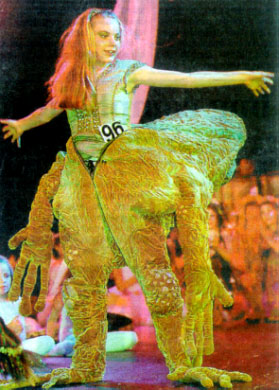Wearable Art show
Read the newspaper article 'Flipflop Rachel the frog princess'. Then answer the following questions.
|
Flipflop Rachel the frog princess |
|
|
Few models fear tripping over their feet onstage, but few have to walk in the floppers Rachel Lean wears as a frog princess.
Rachel, 12, wore a costume by Wellington designer Annemiek Weterings in the Montana New Zealand Wearable Art Awards in Nelson last night.
It was the first of three nights of the awards. Rachel wore a large toad suit, then burst out of it dressed as a princess.
"It's a little scary because I have to hop along and sometimes my toes double up and I'm scared I'll fall over," she said.
Weterings said the costume, which she called Puddocky, showed that "beauty was in the eye of the beholder".
Rachel said modelling the costume was "not that hard", but the top was quite heavy.
"All I have to do is place my arm through, unzip it, flick it back and push my way out."
Children's model assistant Janet Sowman said stamina was an essential to the smooth running of the show.
The final show is tomorrow night.
|
SURPRISE! – Rachel Lean bursts out of a costume by Wellington designer Annemiek Weterings at the Wearable Art Awards in Nelson last night. Picture: Nelson Mail |


